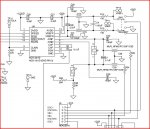I have reached a limit on figuring out how to read 24 bit data into 3 registers and would like some help and a example block of code to how this is done.
The chip used clocks the data in msb first, and each bit is clocked in via a sclk pin.
The data sheet for the chip used is attached.
Perhaps i have just run out of brain cells, but i have hit a brick wall on this one.
Picaxe chip is a 08m
SCLK is on pin 2
Data is on pin1
Little miffed here.
Thanks in advance
The chip used clocks the data in msb first, and each bit is clocked in via a sclk pin.
The data sheet for the chip used is attached.
Perhaps i have just run out of brain cells, but i have hit a brick wall on this one.
Picaxe chip is a 08m
SCLK is on pin 2
Data is on pin1
Little miffed here.
Thanks in advance
Attachments
-
473.2 KB Views: 52

